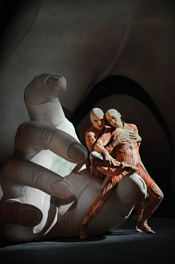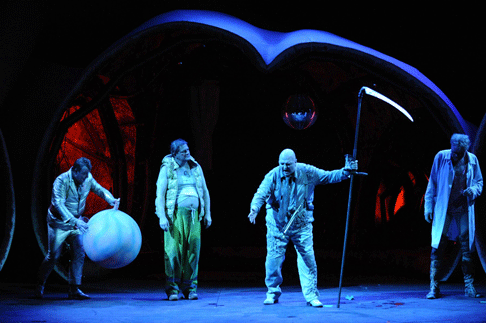The giant woman is a miracle of motors and pulleys, engineering transfigured as art. She’s obviously not alive, but she moves, following the action. She takes on whatever is projected onto her, changing with light from woman to man, aging, decaying, turning into a skull. She’s solid enough to support actors crawling over her yet seems to disappear into starlight or clouds when the lighting’s right. Her body opens to reveal secret caverns. She’s so wonderful, you’re mesmerized.
“A dress rehearsal for the end of the world” wrote Michel de Ghelderode whose original play inspired Ligeti’s “anti-opera”. Le Grand Macabre is an apocalyptic vision after Heironymous Bosch, Theatre of the Absurd at its most picaresque. Nothing is supposed to make sense, all logic overturned. So lovers Amando and Amanda (Frances Bourne and Rebecca Bottone, both women) wear their muscles outside their skin. Nekrotzar, note the nameplay, (Pavlo Hunka) is the all powerful figure of Death, who rides a plastic bubble horse while wielding a scythe.
 Rebecca Bottone (Amanda) and Frances Bourne (Amando)
Rebecca Bottone (Amanda) and Frances Bourne (Amando)
There’s lots of action, for this is Breughelland, teeming with busy figures. Venus (Susanna Andersson) slides down from the ceiling, and later appears as singing stormtrooper. Lots of deliberately unerotic sexual shennanigans - Astramodars (Frode Olsen) and his wife Mescalina (Susan Bickley), she of the conical size ZZ bra cups. The Black Minister (Simon Butteries) and The White Minister (Daniel Norman) exchange playground obscenities in alphabetical order. Piet the Pot ((Wolfgang Ablinger-Sperrhacke) is a down to earth drunk. Prince Go-Go (Andrew Watts, the countertenor) portrays a sad Elvis impersonator, his naivety no match for the evil plotters around him. There’s even a recreation of Michael Jackson’s *Thriller *dance routine to keep the chorus and actors on their toes.
It’s wildly madcap, lots of fun if taken on its own terms. Judging by the laughter most of this audience got the right mood. But the difficulty with Le Grand Macabre, is that it’s not easy to marry humour with horror. Some of Ligeti’s jokes are pretty asinine anyway, without the saving grace of shock, but there’s a lot more darkness and despair in his music than this production dwells on. On the other hand, human nature being what it is chooses levity over grim surreality .
In the Second Act, where Ligeti writes longer musical passages without narrative, Baldur Brönimann got reasonably idiomatic playing from the orchestra. Nonetheless this isn’t Ligeti at his most subtle, and most of the audience were there for the show not the music. Since this production had so much going for it that its sheer inventive energy was compensation for the relative lack of musical bite. Nothing to scare away Those Who Fear New Music. This production was so impressive that it will stick in the memory . For once, it will be good to listen to a recording (ideally Salonen) allowing La Fura del Bas’s incredible images come to life again in your imagination. You can hear the music again, but you’ll never see another production quite like this !
 Andrew Watts (Prince Go-Go), Wolfgang Ablinger - Sperrhacke (Piet the Pot), Pavlo Hunka (Nekrotzar) and Frode Olsen (Astradamors)
Andrew Watts (Prince Go-Go), Wolfgang Ablinger - Sperrhacke (Piet the Pot), Pavlo Hunka (Nekrotzar) and Frode Olsen (Astradamors)
Yet ultimately, Le Grand Macabre isn’t all that macabre. Death is overturned. Prince Go-Go is arrested because he isn’t dead. Piet, Astromodars and Mescalina, return to life and carry on as before. Nekrotzar is defeated and doesn’t come back. Instead he’s replaced by a shrunken puppet, inside the giant woman’s stomach. Then the giant’s features bloom again, colour returning to her cheeks, and she smiles. She’s remarkably realistic now, so it’s quite frightening seeing her eyeball to eyeball if you’re sitting upstairs. The giant woman’s face came from a film at the very beginning, where a sad, lonely woman seemed to be dying of a heart attack. She doesn’t die, but such a shambles of an existence is hardly life. It was uncomfortable seeing her “dead” body subject to indignities, but seeing the real actress who plays her in the film taking applause later wasn’t reassuring. Which is perhaps the point - we can’t assume everything’s back to normal, whatever normal “is”.
Ligeti’s Le Grand Macabre runs at the ENO until October 9th.
www.eno.org


